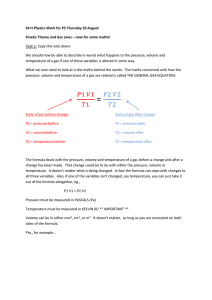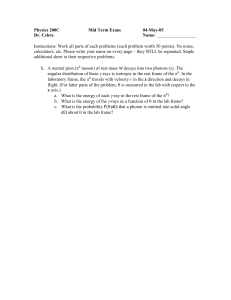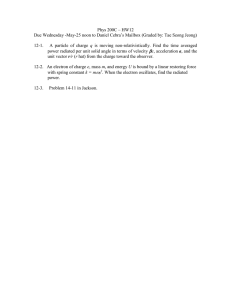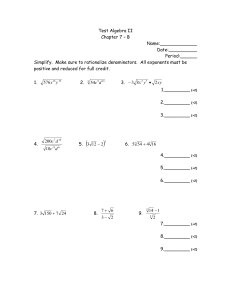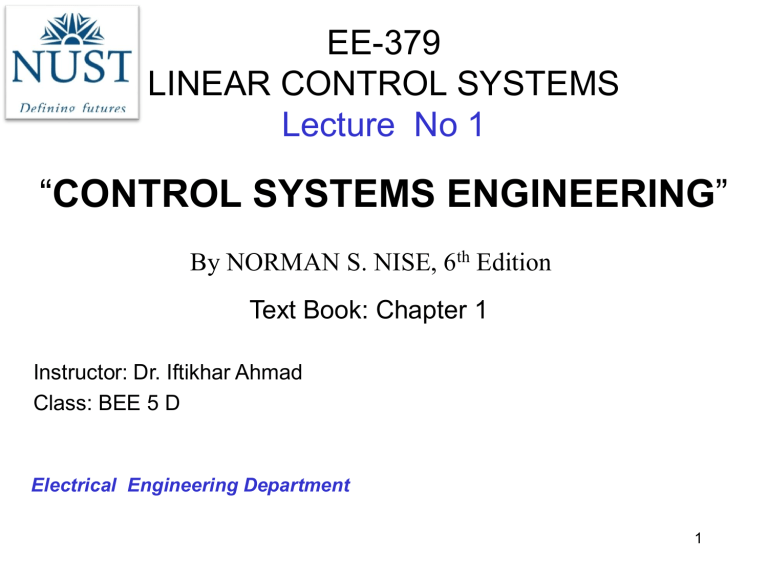
EE-379 LINEAR CONTROL SYSTEMS Lecture No 1 “CONTROL SYSTEMS ENGINEERING” By NORMAN S. NISE, 6th Edition Text Book: Chapter 1 Instructor: Dr. Iftikhar Ahmad Class: BEE 5 D Electrical Engineering Department 1 Course Information Course Title: LINEAR CONTROL SYSTEMS Lab (yes) Credit hrs: 3-3 Prerequisites For this Course: Calculus, Complex Variables and Transforms, Machines Instructor: Dr. Iftikhar Ahmad e-mail :iftikhar.rana@seecs.edu.pk SMRIMMS, Room: C-302 Control Systems Engineering by Norman S. Nise 6th Edition Reference Book(s): 1. Feedback Control Systems by Phillip and Harbor 4th Edition 2. MODERN CONTROL SYSTEMS by RICHARD C DORF Text Book:. 2 Main Topics No. Topics 1 Introduction 2 Modeling in the frequency domain 3 Time response of systems 4 Reduction of multiple subsystems 5 Steady state errors OHT-1 6 Root locus 7 Design via root locus 8 Frequency response techniques OHT-2 9 Design via frequency response 10 Modeling in time domain – State Space 11 Design via State Space End Semester Exam 3 Assignments & Lab Reports: • The assignments will be submitted as desired by the instructor. • The labs will be conducted every week. Grading Policy: Quizzes Assignments OHT 1 OHT 2 End Semester Test : : : : : 10 % 5% 12.5 % 12.5% 35% Labs : 25 % 10% Lab report 5% Viva 10% Lab Exam 4 5 The point is learning, Learning requires effort. There are no shortcuts here! Every time you seek to find a shortcut in learning, what you are actually doing is cheating yourself. Grade: F or D Learner Lecture, Book, etc. Information Source Class Input 6 First: Never ever limit yourself to a single source of information Use multiple sources Lecture, Book, etc. Grade: C Information source ask an expert Learner Information source read a book Information source read another book Information source Internet search 7 Secondly: Your use of information sources must be full of life to be fully effective. Approach each of your sources with specific questions in mind, with the goal of finding answers to those questions: Grade: C+ or B Query Information source ask an expert Query Learner Information source read a book Information source read another book Information source Internet search Query Query 8 Thirdly: Apply what you collect from your sources. Don't just let that information lie idle in your brain – put it into immediate action. This is where you begin to construct your own understanding: Grade: B+ Application Write in your own words Application Describe what U learn output Application Teach your friend Application Build something Application 9 Practice, practice, practice Lastly: Treat the results of your application as another source of information, querying and learning from these efforts as though they were primary sources (like experts or books). This last step establishes a feedback loop, enabling the learner to self-correct errors in understanding: Grade: A 10 Attendance and Expectations Attendance in class is Mandatory Class Etiquette: (1) Don’t read other inappropriate materials in the class (2) Don’t talk to anyone other than the instructor (3) Don’t arrive late or leave early (4) Don’t do work unrelated to this class (5) Don’t sleep in class (8) Don’t use cell phones in the class (9) Don’t violate NUST Code of Student Conduct 11 Synchronous Machine Main Field Slip rings Pole Fan DC excitation winding ROTOR STATOR Main Armature Red Yellow Three-Phase output Blue 18 E A K 13 Control Systems (Definition) Comprises subsystems and processes (or plants) assembled for the purpose of obtaining a desired output with desired performance, given a specified input. Signals flow from the input, through the system and produce an output 14 Control Systems (Example) Consider an elevator. When the fourth-floor button is pressed, the elevator rises to the fourth floor with a speed and floorleveling accuracy designed for passenger comfort. Two measures of performance are : (1) the transient response (2) the steady-state error. Passenger comfort and passenger patience are dependent upon the transient response 15 Classification of Control Systems Control Systems Natural Man-made Manual Automatic Open-loop Non-linear linear Time variant Time invariant Closed-loop Non-linear linear Time variant Time invariant 16 System Configurations Block diagrams of control systems: open-loop system closed-loop system 17 Antenna azimuth position control system: system concept detailed layout 18 Antenna azimuth position control system: Schematic diagram functional block diagram 19 Response of a position control system showing effect of high and low controller gain on the output response 20 The control system design process 21 One Example Disturbance Forces Desired position R (s) Control algorithm (Brain) Controller Reference Neural Signal Hand G(s) Muscle Actuator Control block U (s) Output Position Y(s) Plant Input Eye Sensor Open loop No Feedback Closed loop With Feedback 22 Another Example Disturbances parties, games Desired Performance Teaching activities Actuator Pedagogism R (s) Controller Reference performance Students U (s) Control block Y(s) Plant Input Homework, Exams, quizzes,… Sensor Open loop No Feedback Closed loop With Feedback Blindly teaching ?! 23 What is a Actuator? • Actuator is a device which produce mechanical energy (output motion) in response to some type of energy input. Complex Electrical Mechanical Thermal Energy Fluid • Hydraulic • Pneumatic Actuator Motion Linear ElectroMechanical Rotary Chemical 26 What is a sensor? Sensors are transducers that produce (transform) electrical energy (signals) as a result of some type of stimulation (measurement space) Temperature Distance Measurement Sensor Electrical Signals Voltage Voltage Current Digital Force Speed Types of Sensors Active.. Need External Power 27 Passive.. No External Power Use of Sensors in Feedback Control: In The Next 3-Slides Air condition Cooling System is explained 28 Temperature + - 200C 220V, 50Hz 150C mV 15 20 WAPDA Supply Reference Error=0 volts 20mV= 200C + - +- 200C Compensator Desired Gain=10 20mV Amplifier (Op-Amp 2mV Thermistor Converts Heat into volts 29 Temperature + - 200C 220V, 50Hz 150C mV 15 Reference 20mV=200C +- 20 WAPDA Supply Error=+5 v 150C Compensator Desired Gain=10 15mV 1.5mV 30 Temperature + - 200C 220V, 50Hz 150C mV 15 20 WAPDA Supply Error= -5 v Reference 20mV=200C +- 250C Compensator Desired Gain=10 25mV 2.5mV 31 ??? 32
